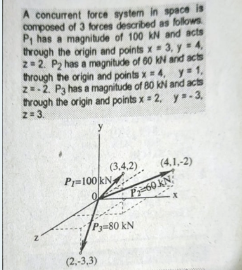A concurrent force system in space is composed of 3 forces described as folows Pi has a magnitude of 100 kN and acts tvough the origin and points x 3, y 4, 22. P2 has a megnitude of 60 kN and acts through the origin and points x4, 2.2. Pa has a magnitude of 80 kN and acts trough the origin and points x 2, y ▪ - 3, 23. y 1, (4,1.-2) (3,4,2) P-100 kN Pi60 KN Py-80 kN (2,-3,3)
A concurrent force system in space is composed of 3 forces described as folows Pi has a magnitude of 100 kN and acts tvough the origin and points x 3, y 4, 22. P2 has a megnitude of 60 kN and acts through the origin and points x4, 2.2. Pa has a magnitude of 80 kN and acts trough the origin and points x 2, y ▪ - 3, 23. y 1, (4,1.-2) (3,4,2) P-100 kN Pi60 KN Py-80 kN (2,-3,3)
Related questions
Question
Subjet: Statis
show your solution please
1. which of the following most nearly gives the x-component of the resultant force.
2. which of the following most nearly gives the y-component of the resultant force.
3. which of the foolowing mosty nearly gives the z-component of the resultant force.

Transcribed Image Text:A concurrent force system in space is
composed of 3 forces described as follows
P, has a magnitude of 100 kN and acts
through the origin and points x 3, y 4,
22. P2 has a megnitude of 60 kN and acts
through the origin and points x4, y 1,
2-2. Pa has a magnitude of 80 kN and acts
trough the origin and points x 2, y =-3,
2=3.
y
(4,1,-2)
(3,4,2)
Pr=100 kN
Pi60 N
Py=80 kN
(2.-3,3)
Expert Solution
This question has been solved!
Explore an expertly crafted, step-by-step solution for a thorough understanding of key concepts.
Step by step
Solved in 3 steps
